The future of transportation is being shaped by a convergence of exciting innovations, transforming the way we move people and goods. From electric vehicles and autonomous technologies to smart city infrastructure and mobility-as-a-service platforms, the transportation industry is undergoing a profound evolution. These advancements promise to address pressing issues like travel-related pollution and traffic congestion, ushering in a new era of sustainable, efficient, and connected mobility.
Over the next decade, commuters can expect to see a surge in electric vehicles, autonomous aerial vehicles, delivery drones, driverless cars, flying taxis, hyperloop, and maglev trains. These emerging transportation technologies will redefine transit and mobility options, offering more carbon-neutral and autonomous solutions to address the challenges of modern transportation.
Key Takeaways
- The future of transportation is being shaped by advancements in electric vehicles, autonomous technologies, smart city infrastructure, and mobility-as-a-service platforms.
- Emerging transportation technologies, such as autonomous aerial vehicles, delivery drones, driverless cars, and high-speed rail, promise to address issues like travel-related pollution and traffic congestion.
- Over the next decade, commuters can expect to see a surge in sustainable, efficient, and connected mobility options that prioritize electrification, automation, and multimodal shared transportation.
- The transportation industry is undergoing a profound evolution, with the convergence of innovations across autonomy, electrification, sharing, connectivity, and sustainability.
- Thoughtful regulation and planning are vital to maximize the benefits and minimize the disruption of transportation technology advancements across economies, communities, and the workforce.
Electrification and Autonomy
The transportation landscape is undergoing a transformative shift, driven by the rapid advancements in electric vehicles (EVs) and autonomous vehicle technology. These emerging transportation technologies are poised to reshape the way we move, offering a glimpse into a future of greater mobility, automation, and innovation.
Electric Vehicles (EVs)
The growing adoption of electric cars marks a significant milestone in the transition towards sustainable transportation. EVs boast superior energy efficiency, lower emissions, and reduced maintenance costs compared to traditional internal combustion engine vehicles. As battery prices continue to decline and charging infrastructure expands, EVs are reaching a level of cost and convenience parity with their conventional counterparts. Many of the world’s leading automakers have committed to going fully electric in the coming decade, further accelerating this shift.
Autonomous Vehicle Technology
Autonomous vehicles, or self-driving cars, are another transformative technology revolutionizing the transportation landscape. Powered by advanced sensors, artificial intelligence, and sophisticated algorithms, these driverless cars hold the promise of enhancing safety, reducing congestion, and providing greater mobility options for individuals and communities. As the technology continues to evolve, autonomous vehicles are poised to reshape the way we commute, travel, and interact with our urban environments.
Benefits and Challenges
The widespread adoption of electric vehicles and autonomous vehicle technology presents a wealth of benefits, including reduced emissions, improved transportation efficiency, and enhanced accessibility. However, these emerging technologies also face a range of challenges, from regulatory hurdles and infrastructure requirements to consumer acceptance and ethical considerations. As the transportation industry continues to navigate this dynamic landscape, policymakers, innovators, and the public will need to work collaboratively to harness the full potential of these transformative transportation technologies.
High-Speed Transit Solutions

As the world seeks more sustainable transportation options, high-speed rail networks and hyperloop technology are transforming intercity travel. From Japan’s iconic bullet trains to China’s expansive high-speed rail system, the viability of these high-speed transit solutions has been firmly established.
High-Speed Rail Networks
High-speed rail networks offer an efficient and environmentally-friendly alternative to traditional air and road travel. These advanced train systems can transport passengers at speeds exceeding 200 mph, significantly reducing travel times between major metropolitan areas. Countries like Japan, China, and several European nations have invested heavily in high-speed rail infrastructure, demonstrating its potential to boost mobility and connectivity across regions.
Hyperloop Technology
Taking high-speed transit to the next level, hyperloop technology propels specialized pods through near-vacuum tubes at airline-like speeds. This innovative approach to intercity travel could potentially connect cities in under an hour, revolutionizing long-distance passenger and cargo transport. While challenges around infrastructure costs, safety, and rider experience remain, hyperloop is poised to redefine the future of transportation.
As high-speed rail and hyperloop systems continue to evolve, they promise to enhance mobility, connectivity, and sustainable transportation across the globe. By offering faster, more efficient, and environmentally-friendly alternatives to traditional modes of travel, these innovative transit solutions are set to transform the way we move people and goods between cities and regions.
Mobility as a Service (MaaS)
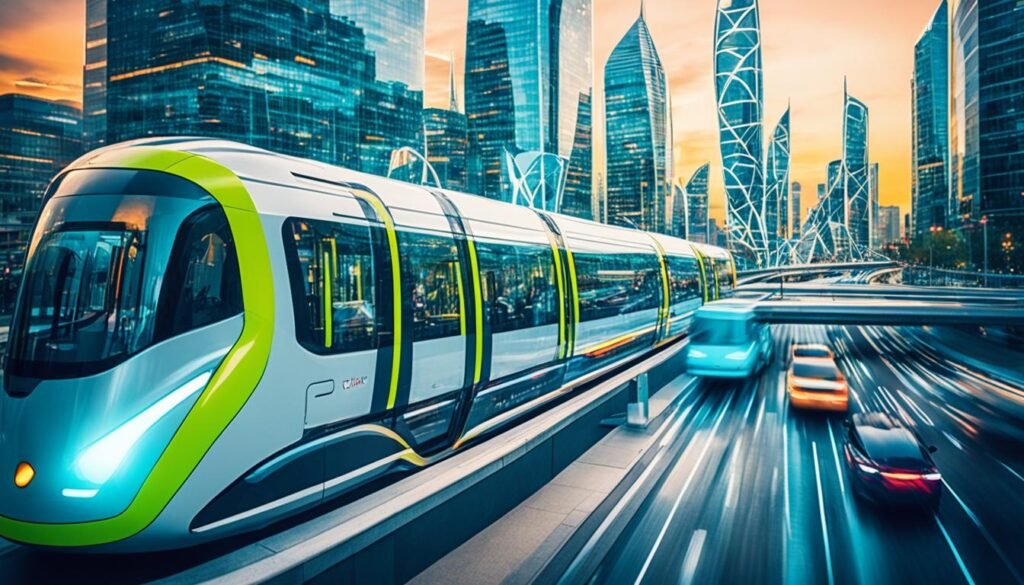
Mobility as a Service (MaaS) platforms are an emerging concept that integrates various transportation modes through a single-user app. MaaS apps allow users to plan, book, and pay for journeys across public transit, rideshares, scooters, and bike shares. This convenience can encourage a shift from private car ownership to shared mobility, reducing congestion and emissions.
For cities, MaaS provides valuable data insights to optimize transit capacity and operations, transforming urban mobility. By unifying different transportation apps into a seamless integrated mobility experience, MaaS has the potential to reduce reliance on personal vehicles and promote more sustainable mobility as a service solutions.
| Benefits of MaaS | Challenges of MaaS |
|---|---|
|
|
As mobility as a service platforms continue to evolve, they hold the promise of transforming how we navigate our urban mobility landscape, fostering more sustainable and efficient transportation modes for the future.
Drone Transportation

Drones have rapidly expanded from military to consumer applications, with significant potential for transforming both cargo delivery and urban air mobility. Companies like Amazon and UPS are testing drone technology for fast and cost-effective last-mile delivery, showcasing the power of drone transportation to revolutionize logistics. Meanwhile, passenger drones like the Volocopter are being developed to provide on-demand urban air taxi services, promising to alleviate traffic congestion and enhance urban mobility.
Cargo Delivery Drones
The rise of cargo delivery drones is poised to disrupt the traditional logistics industry. These unmanned aerial vehicles can efficiently transport packages over short to medium distances, reducing delivery times and costs. E-commerce giants and logistics providers are actively exploring drone-based delivery models to enhance their last-mile capabilities and cater to the growing demand for instant gratification. As the technology continues to mature and regulatory frameworks evolve, cargo delivery drones hold immense promise for streamlining urban logistics and transforming the future of parcel transportation.
Passenger Drones and Urban Air Mobility
Beyond cargo transport, the concept of urban air mobility (UAM) is gaining traction, with the development of passenger-carrying drones and flying cars. These aerial vehicles, also known as electric vertical take-off and landing (eVTOL) aircraft, are designed to provide on-demand, short-haul transportation within and between cities. Companies like Volocopter, Joby Aviation, and Lilium are at the forefront of this new frontier, aiming to alleviate urban congestion and offer a novel mode of transportation that complements existing ground-based options. While regulatory hurdles and safety concerns must be addressed, the potential of passenger drones to transform urban mobility is garnering significant attention and investment.
Smart Infrastructure
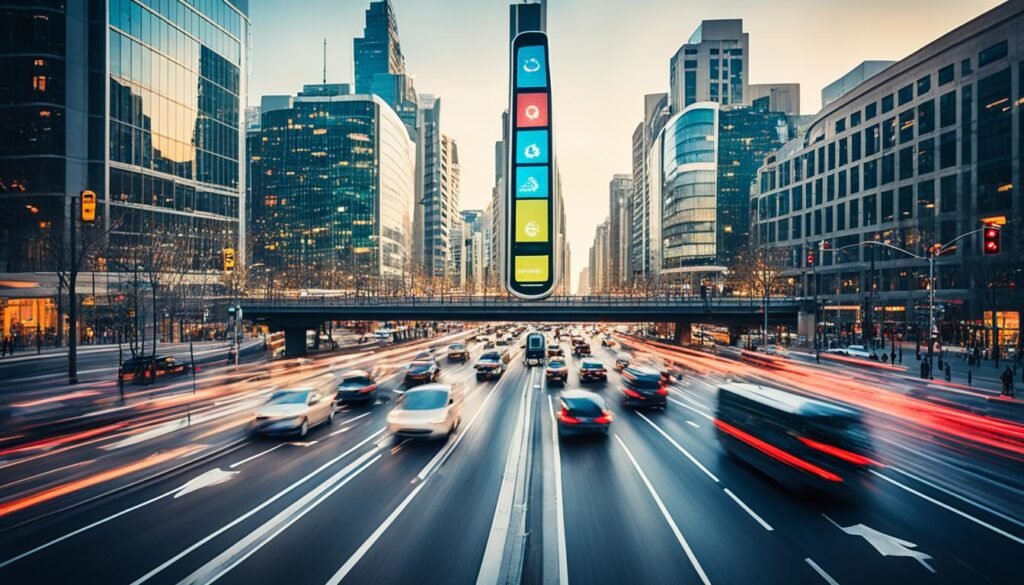
As transportation technologies continue to advance, smart infrastructure is emerging as a vital component in optimizing the movement of people and goods. Smart infrastructure refers to the integration of sensor-embedded roads, bridges, and traffic systems that enable real-time monitoring and dynamic response to changing conditions. These intelligent networks of sensor-embedded roads and smart highways can alert approaching vehicles to hazards, adjust streetlights based on traffic and ambient light, and seamlessly integrate with navigation apps and autonomous vehicle coordination.
Sensor-Embedded Roads and Bridges
The deployment of sensor-embedded roads and bridges is transforming the way transportation infrastructure operates. These smart elements are equipped with a network of sensors that continuously gather real-time data on factors like traffic flow, weather conditions, and potential hazards. By analyzing this data, transportation authorities can optimize traffic optimization and improve overall transportation infrastructure efficiency and connectivity.
Dynamic Traffic Management
Integrating this sensor-driven data with advanced analytics and communication technologies enables dynamic traffic management systems. These systems can proactively respond to changing conditions, adjusting traffic signals, rerouting vehicles, and providing dynamic guidance to drivers through connected smart city applications. By smoothing traffic flow and improving road utilization, dynamic traffic management helps reduce congestion, enhance safety, and lower emissions.
Leading smart city initiatives around the world, such as those in Singapore, Dubai, and Spain, are at the forefront of testing and deploying these transformative smart infrastructure technologies. As the integration of sensors, connectivity, and data-driven decision-making continues to advance, the future of transportation will be defined by increasingly intelligent and responsive smart highways that optimize the movement of people and goods.
Transportation Technology

The future of transportation is being shaped by the convergence of cutting-edge technologies, including vehicle-to-everything (V2X) connectivity and the rollout of 5G networks. These advancements hold immense potential to revolutionize transportation safety, efficiency, and the overall driving experience.
Vehicle-to-Everything (V2X) Connectivity
V2X communication enables the seamless exchange of data between vehicles, infrastructure, pedestrians, and other elements within the transportation ecosystem. This technology allows vehicles to coordinate their movements, navigate intersections, and anticipate potential hazards, significantly reducing the risk of accidents and traffic bottlenecks.
5G and Dedicated Short-Range Communications (DSRC)
Reliable, low-latency connectivity is crucial for the successful implementation of V2X systems. The emergence of 5G networks, combined with protocols like Dedicated Short-Range Communications (DSRC), provides the split-second responsiveness required for vehicle-to-vehicle and vehicle-to-infrastructure communication. This robust connectivity, when paired with autonomous driving capabilities, holds immense potential to revolutionize transportation safety and efficiency.
| Technology | Description | Key Benefits |
|---|---|---|
| Vehicle-to-Everything (V2X) | The ability for vehicles to communicate with other vehicles, infrastructure, pedestrians, and other elements in the transportation ecosystem. | Improved safety, reduced accidents, enhanced traffic flow, and optimized transportation operations. |
| 5G and DSRC | High-speed, low-latency wireless communication networks and protocols that enable reliable, real-time data exchange for V2X applications. | Facilitates the effective implementation of V2X systems, enabling autonomous and connected vehicle technologies to reach their full potential. |
By integrating V2X connectivity with autonomous driving capabilities, transportation technology holds the promise to drastically improve road safety, traffic management, and overall transportation system efficiency. As these innovative solutions continue to evolve, they will undoubtedly shape the future of how we move people and goods across the United States and beyond.
Sustainable Transportation Solutions
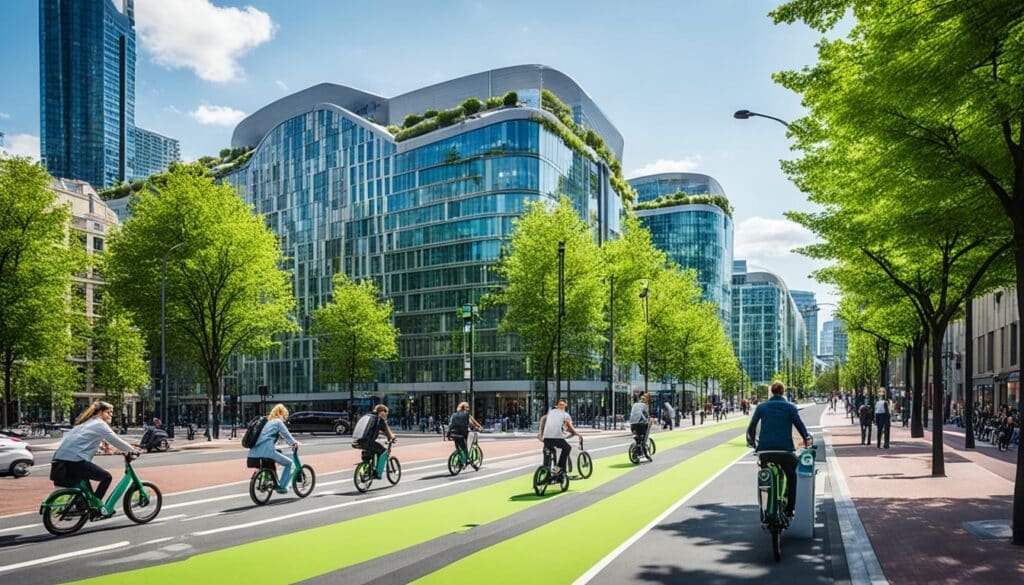
Technology is crucial for developing sustainable transportation systems. The growth of electric vehicles, integration of renewable energy, lightweight materials, and electrified public transit are all bringing down emissions. Data analytics optimize logistics routes and capacity utilization, while apps promote shared mobility options. Charging infrastructure and smart grid innovations further support the transition to renewable energy-powered transportation.
Many cities are also redesigning transit-oriented urban spaces to prioritize walking, cycling, and public transport, reducing private car dependency. Continued breakthroughs in battery technology, renewable energy, and mobility analytics will accelerate the shift towards a more sustainable transportation future.
Renewable Energy Integration
The electrification of transportation is closely tied to the integration of renewable energy sources. Electric vehicles (EVs) charged with clean, renewable electricity significantly reduce emissions reduction and environmental impact compared to traditional internal combustion engines. Innovations in battery technology, smart grids, and renewable power generation are making this transition more feasible and cost-effective.
Shared Mobility and Transit-Oriented Development
Shared mobility options like ridesharing, carsharing, and microtransit are becoming more prevalent, reducing the need for private vehicle ownership. When combined with transit-oriented development, where residential and commercial areas are designed around public transportation hubs, these shared mobility solutions can further encourage a shift away from private cars. This multimodal approach to urban planning and mobility solutions is crucial for creating more livable, green transportation-oriented cities.
Advanced Navigation Systems
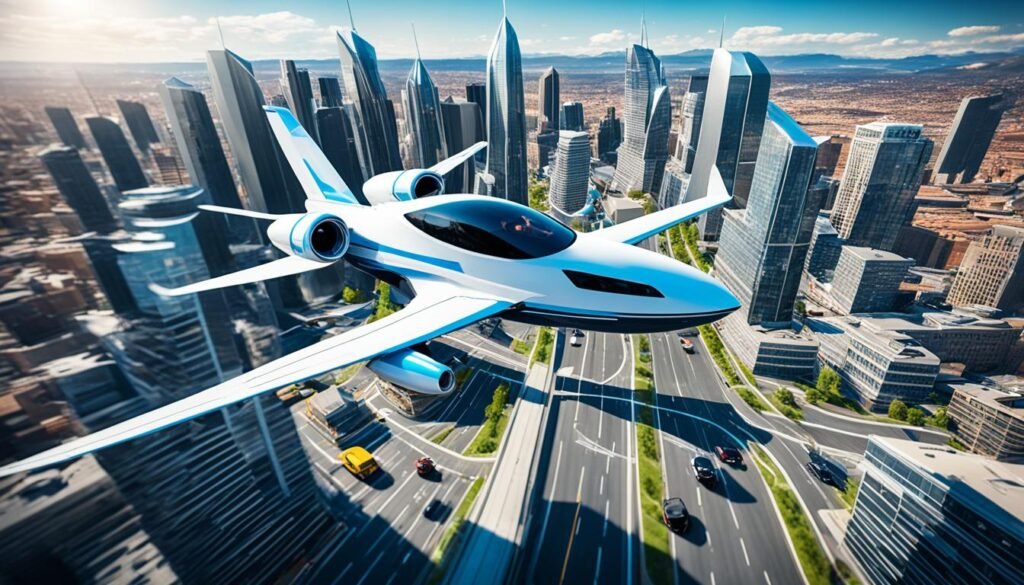
As transportation technology continues to evolve, real-time navigation systems are becoming increasingly sophisticated, leveraging a wealth of data sources and advanced algorithms to provide drivers and pedestrians with more accurate, personalized guidance. Augmented reality is emerging as a powerful tool in this space, allowing digital route information and contextual cues to be seamlessly overlaid onto the user’s view, enhancing their situational awareness and decision-making.
Augmented Reality Navigation
Augmented reality (AR) navigation systems can project turn-by-turn directions, traffic updates, and other relevant data directly onto the windshield or a head-up display in the driver’s line of sight. This technology not only reduces the need to continually glance at a separate navigation screen but also enables users to keep their eyes on the road, improving safety and reducing cognitive load. As AR hardware becomes more affordable and widespread, the integration of this immersive navigation experience is poised to transform how we navigate our surroundings, whether in a vehicle or on foot.
Personalized Route Guidance
Navigation apps are becoming increasingly adept at providing personalized route recommendations and dynamic alternative routes based on user preferences, driving habits, and real-time traffic conditions. Leveraging historical data, sensor networks, and predictive analytics, these advanced navigation systems can warn drivers of potential bottlenecks and suggest optimal paths to avoid congestion. By tailoring the navigation experience to individual users, these apps empower commuters to make informed decisions that align with their specific needs, whether prioritizing travel time, fuel efficiency, or other factors.
Looking ahead, continued breakthroughs in areas like holographic navigation, brain-computer interfaces, and heads-up displays could further elevate navigation systems from static platforms to contextual digital assistants that seamlessly integrate with the user’s mobility experience, enhancing overall efficiency and convenience.
Economic and Job Market Impacts
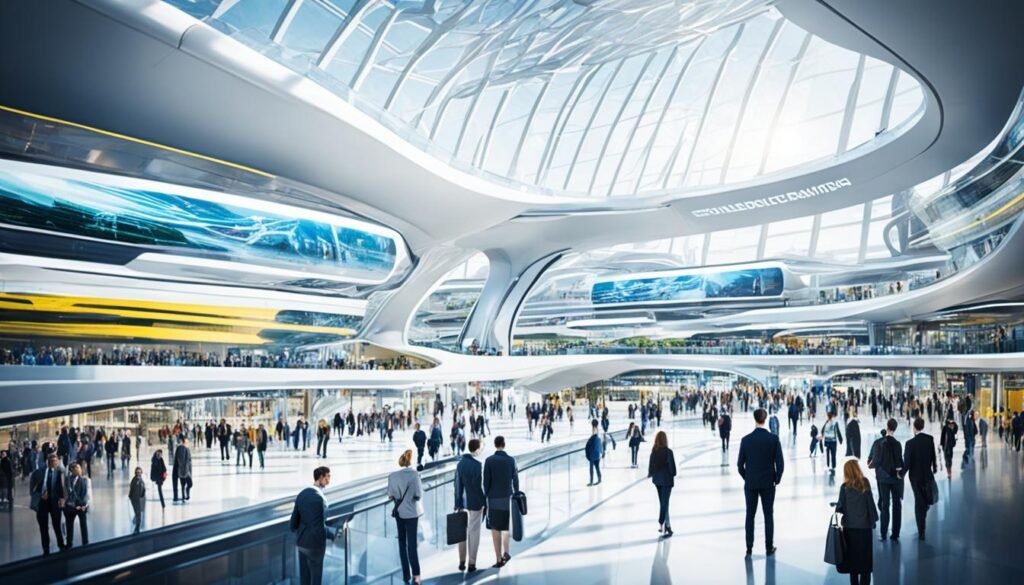
The rapid advancements in transportation technology will have significant economic and job market implications. Automation and autonomous systems are poised to disrupt traditional industries, potentially replacing millions of jobs, particularly in sectors like logistics and manufacturing. Self-driving trucks, for instance, could replace the roles of countless truck drivers, while simpler electric vehicle (EV) drivetrains may reduce the need for maintenance and repair jobs.
Automation and Job Displacement
According to estimates, autonomous and robotic solutions across supply chains and manufacturing could potentially replace up to 20 million jobs worldwide by 2030. This widespread job displacement due to automation and transportation technology will require strategic planning and proactive policies to address the economic impacts and social disruption.
New Skills and Business Opportunities
However, these technological innovations will also create new kinds of jobs, skills, and business opportunities. The shift towards electric, autonomous, and connected transportation will necessitate the development of a workforce with expertise in areas like software engineering, data analytics, and systems integration. Policymakers and educational institutions must prioritize retraining and upskilling initiatives to equip workers with the necessary capabilities to thrive in the evolving transportation landscape.
Additionally, the rise of transportation technology will unlock new business models and revenue streams, ranging from fleet management services and mobility-as-a-service platforms to infrastructure maintenance and smart city consulting. Entrepreneurs and established companies alike must be prepared to capitalize on these emerging opportunities, driving economic growth and resilience.
As transportation technology continues to evolve, policymakers, businesses, and workers must collaborate to navigate the complex economic and job market impacts. Comprehensive labor reforms, educational programs, and targeted investment in retraining will be crucial to ensure a smooth transition and harness the full potential of these technological advancements.
Also Read: Navigating The Digital Frontier: Insights From A Technology Consultant
Conclusion
Transportation technology has always evolved in leaps, from the steam engine to digital navigation. We now stand at the cusp of a convergence of innovations across autonomy, electrification, sharing, connectivity, and sustainability. Together, these advancements in transportation technology will radically reshape transportation economics, society, and culture, much like the automobile did a century ago.
However, thoughtful regulation and planning are vital to maximize the benefits and minimize disruption across economies, communities, and the workforce. The future beckons us to innovate, adapt, and prepare with wisdom as transportation technology continues to transform the way we experience mobility and move people and goods.
As we embrace the promising future of transportation technology, it is crucial that we navigate the changes with foresight and consideration for the societal impact. By striking a balance between technological innovation and thoughtful adaptation, we can unlock the full potential of these advancements to create a more efficient, sustainable, and equitable transportation landscape for generations to come.
FAQs
Q: What are some advancements in transportation technology beyond roads?
A: Advancements in transportation technology beyond roads include innovations in railway systems, air travel, transit services, and emerging technologies like high-speed rail and autonomous vehicles.
Q: How do emerging technologies help reduce traffic congestion?
A: Emerging technologies such as data collection systems and smart traffic management tools can help transportation agencies analyze traffic patterns, optimize bus routes, and implement dynamic lane controls to reduce congestion on roadways.
Q: Which transportation agencies are focusing on implementing new technologies in 2023?
A: Various transportation agencies and departments of transportation across the U.S are prioritizing the adoption of new technologies in 2023 to modernize existing transportation systems and enhance the efficiency of transit services.
Q: What are some of the innovative transportation trends expected to dominate the industry in the coming years?
A: Innovative transportation trends such as the use of autonomous vehicles, electric bicycles, hyperloop technology, and advanced transit systems are anticipated to be the big things in transportation tech, aiming to revolutionize the way people and goods are transported.
Q: How does advancements in transportation technology benefit the freight industry?
A: Advancements in transportation technology like high-speed rail, drone delivery systems, and efficient cargo transportation methods help improve the reliability and speed of freight deliveries, ensuring the timely transportation of goods and medical supplies.
Q: What role do technology trends play in the evolution of transit systems?
A: Technology trends play a crucial role in the evolution of transit systems by enabling transit agencies to offer more efficient and sustainable transport options, enhance connectivity, and improve the overall passenger experience.
Q: How do advancements in transportation technology impact the speed and efficiency of travel?
A: Innovations in transportation technology such as high-speed trains, electric vehicles, and advancements in air travel significantly increase the miles per hour that passengers can travel, making transportation faster and more efficient.




